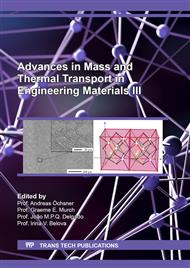[1]
C. Herring, N. M. Johnson, C. G. Van de Walle. Phys. Rev. B. 64, 125209 (2001).
Google Scholar
[2]
R. Jones. Phil. Trans. R. Soc. Land. A,350, No. 1693, 189 (1995).
Google Scholar
[3]
U. Lindefeltt , A. Zunger. J. Phys. C: Solid State Phys., 17 6047 (1984).
Google Scholar
[4]
L. Bilteanu, M. Posselt, J.-P. Crocombette. arXiv:1111.6455 [cond-mat.mtrl-sci]. 2011 14: 49: 13.
Google Scholar
[5]
A. Mainwood. Properties of Crystalline Silicon. 15, 110 (1999).
Google Scholar
[6]
H. Mehrer. Diffusion in solids: fundamentals, methods, materials, diffusion-controlled processes. – Springer Science & Business Media, (2007).
Google Scholar
[7]
Sc.W.Jones. Diffusion in Silicon. IC Knowledge LLC, April 25, 2008, 68 pages.
Google Scholar
[8]
L. Dobaczewski, K. Bonde Niel Sen , K. Goscinski, O. Andersen. ACTA PHYS. POL. A. 98, 231 (2000).
Google Scholar
[9]
M. Stavola. The 5th International Symposium on Advanced Science and Technology of Silicon Materials (JSPS Si Symposium), Nov. 10-14, pp.337-343( 2008), Kona, Hawaii, USA.
Google Scholar
[10]
V.M. Pinchuk, A. N. Nazarov, V. S. Lysenko, V. M. Kovalev. J. Struct. Chem. 37, 18 (1996).
Google Scholar
[11]
C.P. Flynn and A. M. Stoneham. Phys. Rev. B 1, 3966 (1970).
Google Scholar
[12]
A.M. Stoneham. J. Nucl.Materials.69&70,109-116 (1978).
Google Scholar
[13]
A.M. Stoneham, C. P. Flynn. J. Phys. F: Metal. Phys. 3,505-512 (1973).
Google Scholar
[14]
A.T. Paxton, I. H. Katzarov. Acta Materialia 103, 71 (2016).
Google Scholar
[15]
K.M. Forsythe, N. Makri. J. Chem. Phys. 108, 6819 (1998).
Google Scholar
[16]
E. Matsushita, T. Matsubara, Progr. Theor. Phys, 67, 1( 1982).
Google Scholar
[17]
D.R. Evans. Notes for Microelectronics Fabrication I. 242 Pages. FreeBookCentre.net.
Google Scholar
[18]
A. Mainwood, A. M. Stoneham. J. Phys. C: Solid State Phys., 17, 2513 (1984).
Google Scholar
[19]
E.V. Kalashnikov, I.N. Tolstikhin, B.Z. Pevzner. J. Phys. Solid State, 52, 1372 (2010).
Google Scholar
[20]
E.V. Kalashnikov, I.N. Tolstikhin, N.A. Krylova. Defect and Diffusion Forum. 380, pp.98-106 (2017).
DOI: 10.4028/www.scientific.net/ddf.380.98
Google Scholar
[21]
Ya. Frenkel, T.Kontorova. Zh. Exp. Teor. Fiz. 8,89 (1938). (In Russion).
Google Scholar
[22]
Cuevas, J, Sanchez-Rey, B, Eilbeck, JC and Russell. Discrete and Continuous Dynamical Systems - Series S, 4, 1057(2011). https://doi.org/10.3934/dcdss.2011.4.1057.
Google Scholar


